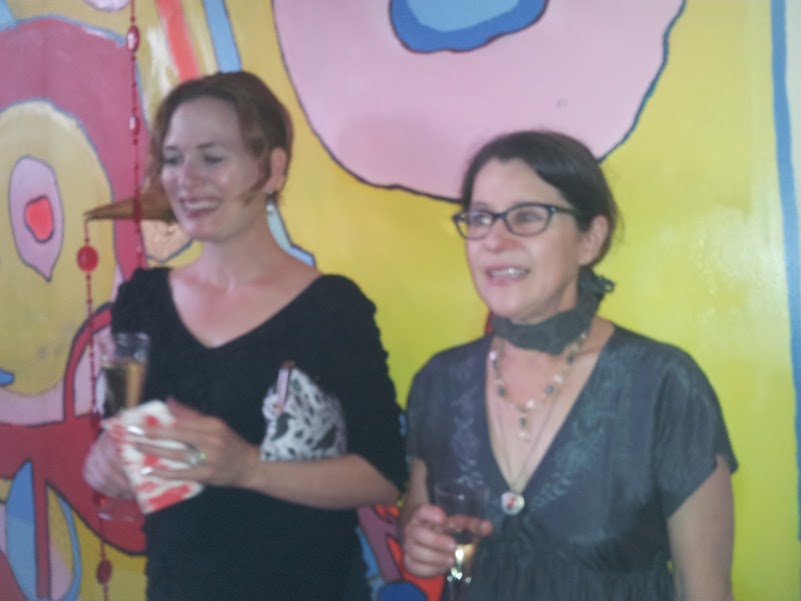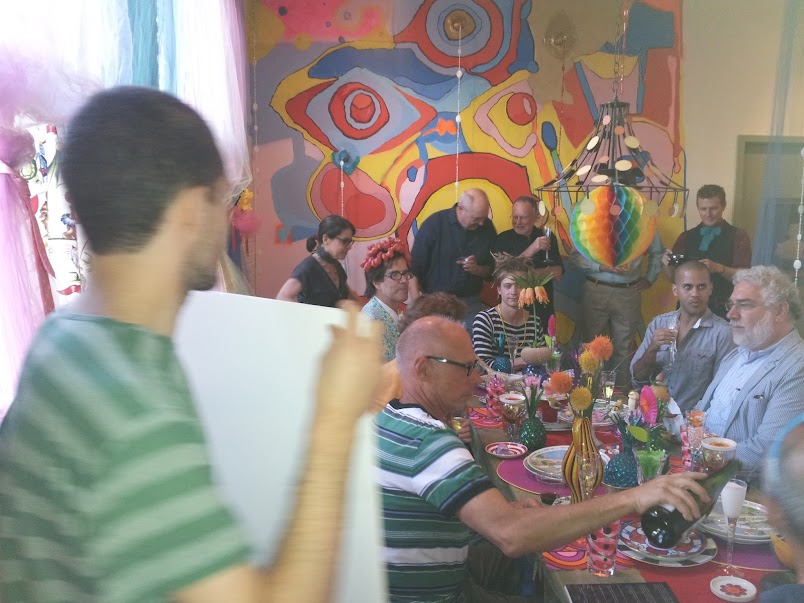Art Counsel
Collections information specialiststhe UWM Golda Meir Special Collections Library needs a dedicated gallery space for its always thought-provoking exhibitions.
I just viewed the “War and Rumors of War: Artists, Veterans, and Artists Books” exhibition curated by Max Yela. As usual the objects, theme, and text are worth some meditation. However, be warned! The objects are in the wall of display cases that compose the hall leading to Special Collections on the fourth floor. The architectural space will sweep you along unless you are really dedicated to viewing the exhibition. This is something to be lamented because Golda Meir Library has many spectacular objects that are truly underserved by this anonymous corporate-esque space that almost apologizes for containing art.
UWM, I beseech you, give Max a real gallery space to work in!
 Though there is a Picasso, a Hayter, a Colescott and many works by recognized regional artists, my favorite is by one of Max’s students, – a darkly witty untitled book, the pages of which are composed of a sliced image sandwiched between shards of glass.
Though there is a Picasso, a Hayter, a Colescott and many works by recognized regional artists, my favorite is by one of Max’s students, – a darkly witty untitled book, the pages of which are composed of a sliced image sandwiched between shards of glass.
Conceptual Space in Milwaukee
For a last hurrah before remodeling as a more open, streamlined space, the Portrait Society Gallery hosted “A Fop’s Banquet, an Exhibition in Three Acts” last night. For those of you unfamiliar, the gallery is dedicated to exploring the concept and function of portraiture in art – a generally underconsidered genre.
Most worth mentioning is the whimsical “banquet room” where guests were invited to participate as part of the exhibition and in a cleverly organized auction, as well as to observe. A professional photographer took portraits and snapshots throughout the evening in all of the gallery rooms so it will be interesting to see if they translate into a new “hall of mirrors” sort of portraiture exhibition.

Kat Murrell and Debra Brehmer
Owner, Debra Bremer has long been working in a participatory curatorial style (the most notable being the Winter Chapel exhibition) that promises to flower into something increasingly more conceptual with the new layout. I am looking forward to making the trip from Chicago to attend its future functions and Ms. Bremer’s curatorial explorations

“A Fop’s Banquet” auction
.
Musings about the MicroMuseums that are Relational Art (repost)
Since beginning exploration of relational aesthetics, my opinions have been troubled. The difficulty has not been with how to stick it in a box and label it – I am refreshed by the many absurdities that are revealed in the attempt to do so. However, the relational event is curiously indefinite regarding its place in the realm of art production. As a trained curator and archivist, to me many relational events seem like curatorships, and their artifacts, like collections. There is also a scientific strain that while refreshing, often slides quite closely to sociopathic puppeteering. That is not to say that string-pulling is anathema to art, but the strings are palpable, almost visible; and they tend to make the participant rather pathetic.
To explain the sense of pathetique, the development of the happening over time needs to be addressed. The more utopian, earlier attempts such as Beuys’ Bureau for Direct Democracy and even Graciela Carnevale’s Experimental Art Cycle with its goal of violence promised a certain inclusivity and universality, yet remain firmly in control of the artist. The audience is part of the show but voluntarily so; therefore retaining a certain level of dignity regardless of their reaction to the staged relational act. Adrian Piper’s later Notes on Funk still retained a hope for the universal experience, but did not bet on it, as it hinged on post-modern historical revisionist strategy intended to educate on some level. Tiravanija’s Pad Thai, however, was not led nor attended by the artist, and was entirely participant led. Predictably, mostly art scenesters attended. This in itself is perhaps an interesting framing of that momentary state of art and society, and there is no sense that this result was intended, but the outcome was, considering its set-up and marketing, fairly likely. Therefore, while the space between the audience and the author has up to this point been closing, this exhibition marks the distancing of the author from a work which consists of audience – and the artist relinquishes a certain amount of personal responsibility for a human situation that s/he created.
This may appear in some ways to be anti-creative, but it is on the contrary an invitation to Chaos that rather flatly gives way to Predictability. Neither force lacks creative potential, but it does expose that Potential is what drives relational concept-building. Further, relational aesthetics is simply a different philosophy/creativity that allows the non-artist to create consciously or not within a constructed social frame, yet creative potential is limited because the vast majority of people (Western tradition anyway) have a century-old rather polite perception of what art is and should be, so the sense of play can be seen as a game of manipulation rather than an opportunity to step into an authored, limited and temporary “culture” that foregrounds the frames we unconsciously construct for ourselves.
REFERENCES
Participation. Ed. Claire Bishop. London: The MIT Press, 2006. Print.
Check out the changes at the Chicago Underground Library
The Chicago Underground Library is now the Read/Write Library. Personally I prefer the old name – more intriguing, describes the kind of collections you might expect to find – so I don’t really get the name change. However, the new space is going to be very cool, I hear and I intend to check it out as soon as it’s all official.
Preparing for Summer
Art Counsel is going to try to find itself this summer, so we are going to try a few new things, including a new web presence with a point-counterpoint feature that we are hoping will bring a little lighthearted fun to the Chicago scene. We will probably begin with Pop-Up Art Loop’s first Thursdays Gallery Walk, but if anyone has other suggestions, please post ’em here.
Graffiti in Hyde Park
On my way to a vlog assignment, I took a shortcut through an alley and saw this.
Word on the street is that the shop owners who share the wall don’t mind the graffiti (I assume, as long as it’s artful), however there was a cop car pretty much laying in wait behind some bushes about halfway down the alley.
If anyone knows the artist(s), I’d like to give her/him full credit. Maybe then I’ll do something more creative with the video, too.
Finally blinking our eyes at the Chicago summer sun
Looks like the new database is going to take a little longer than expected, but that’s because we are trying to make it a bit more interactive than originally planned. It’s also time to slow the project down a notch simply because we aren’t getting out to the galleries.
See you around Chicago! Posting something more interesting soon (I hope).
Sandblasting the Modern Wing
Chicago readers probably already know that the Modern Wing of the AIC was marred by graffiti some days ago – and kudos for the quick response and having it removed as soon as possible. HOWEVER (and this is difficult for me to say without extreme passion or expletive because I was a historian/office manager for a historic masonry preservation firm for eight years), when removing graffiti from historic or otherwise important masonry buildings, sandblasting is the absolute last resort because it permanently damages the weatherproof surface of the masonry and promotes rapid deterioration of structural integrity. You would think that a museum with archives dedicated to architecture would have consulted preservation specialists before going ahead.
By the way, consulting a restoration company is not the same thing as consulting a preservationist. If you ask for sandblasting from a restoration contractor, you will get sandblasting. Restoration firms are in the business of giving the customer what they want, not necessarily what they need. And to be fair, the damage done to the Modern Wing is not the contractor’s fault. They did what they were paid to do. Preservationists are who you want to call when this kind of problem comes up. They are trained to understand long term effects of preservation/restoration efforts and are generally semi-detached from the construction industry so are more likely to give objective advice and to lead you to the proper restoration techniques and specialists.
Anyway, I do not know who is in charge of these kinds of decisions at the AIC (I suspect it is not the architectural archives), but whoever you are, here is a link to a technical preservation brief on graffiti removal techniques from the National Park Service, Department of the Interior that is considered standard by historic preservation departments and societies.
Now, please call a reputable preservationist to ask how to consolidate the masonry to prevent accelerated weathering damage. Sheesh!
Conceptually Speaking, Michael Landy’s “Art Bin” scores a big “Meh”
When the promos for Landy’s Art Bin exhibition were first flying around, it seemed truly subversive, but upon learning that he is not destroying “valuable” art but castoffs, which as artistic failures are really only on the edge of what might be called “art”, the concept was quite disappointing. So what? He is putting garbage in a garbage bin. The only remotely interesting thing seems that the garbage of many is collected at a single onsite orgy of artistic self-absorption.
The concept is touted as “a monument to creative failure” and has no apparent connection to current events and concerns. True, Philip Hensher claims that “Landy’s important…because just at this moment we’re slightly disenchanted with money itself, we’re slightly disenchanted with money’s power to act as an aesthetic judgment in itself.” But this seems looking through the telescope backwards. In a time when loss and hardship are commonly felt due to the economy, and in a world where wasting materials is a guilt-ridden experience due to ecological concerns this seems ill-timed. Not that I think these political concerns are intended to be foregrounded here, as the act of destroying rejected art is not on a level with destroying rain forest with intentional Exxon oil spills. If he is going for shock-value or making his bid as the Siva of the art world, it would seem more powerful to destroy things of real and enduring value to someone, as he did in Break Down, though magnified to everyone. Then again, this would merely seem a bit of one-upmanship were he to do so. Though this is mildly different, it seems muted and even a bit lazy.
Where are the famously resonant recontextualizations? Am I missing something? Yeah I get the undercurrent of the “one man’s trash…” proverb and that Landy is not acting as a “judge” and all things are created equal (blah, blah, blah). Sure, there are many who would like to own even the lowliest of castoffs from some of the donating artists, so perhaps one can cull a certain irony in poking fun at those who would be chagrined at the destruction: those who might be considered junkmen collectors; those who find value in artists’ mistakes; the nouveau riche for bad taste… But really, if this is any part of his intention or of the general reaction, how post-modern (zzzzzzz)! Perhaps the ultimate irony is that this appears to be, all-in-all, a throwaway concept by Landy himself.





